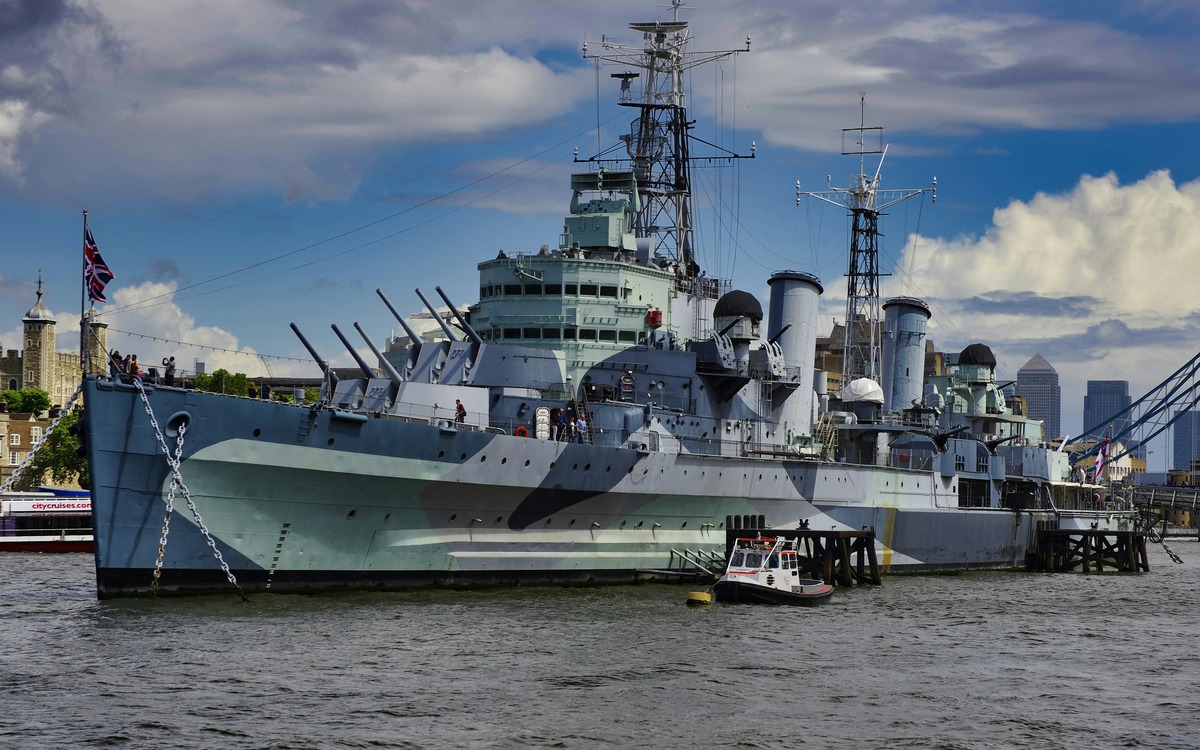Home>History>The Surprising Contrasts Between Battleships And Destroyers


History
The Surprising Contrasts Between Battleships And Destroyers
Published: February 19, 2024
Explore the intriguing history of battleships and destroyers, and discover the surprising differences between these formidable naval vessels. Gain insights into their roles and impact on maritime warfare.
(Many of the links in this article redirect to a specific reviewed product. Your purchase of these products through affiliate links helps to generate commission for Noodls.com, at no extra cost. Learn more)
Table of Contents
Introduction
Naval warfare has long been a captivating aspect of military history, with battleships and destroyers standing out as iconic vessels that have left an indelible mark on the seas. These formidable warships, though both integral to naval operations, possess striking differences in terms of design, capabilities, and historical significance. Exploring the contrasting features of battleships and destroyers unveils a fascinating narrative of innovation, strategic evolution, and the enduring impact of these vessels on maritime warfare.
The history of battleships and destroyers is a testament to the ever-changing nature of naval warfare. From the grandeur of battleships dominating the seas to the agility and versatility of destroyers, each vessel represents a distinct era in naval history. Delving into their evolution and pivotal roles in pivotal conflicts offers a profound understanding of the dynamic interplay between technological advancements and strategic imperatives.
As we embark on a journey through the annals of naval history, we will uncover the defining characteristics of battleships and destroyers, shedding light on their size, armament, speed, maneuverability, and their pivotal roles in naval warfare. Moreover, we will explore their modern applications and the evolving dynamics of naval strategies, providing a comprehensive perspective on the enduring legacy of these awe-inspiring vessels.
The contrasting features and historical significance of battleships and destroyers offer a compelling narrative that transcends mere military history. It is a testament to human ingenuity, strategic foresight, and the relentless pursuit of maritime supremacy. Join us as we unravel the captivating saga of battleships and destroyers, delving into their past, present, and the intriguing possibilities that lie ahead.
History of Battleships
Battleships, often hailed as the epitome of naval power and prestige, have a storied history that spans several centuries. The genesis of battleships can be traced back to the mid-19th century, a time marked by significant advancements in naval technology and the escalating arms race among major maritime powers. The emergence of ironclad warships, equipped with formidable armor and powerful artillery, laid the foundation for the evolution of battleships.
The defining moment in the history of battleships arrived with the commissioning of HMS Dreadnought by the Royal Navy in 1906. This revolutionary vessel, armed with a uniform battery of heavy guns and propelled by steam turbines, set a new standard for naval warfare. The concept of an "all-big-gun" battleship, epitomized by the Dreadnought, sparked a global naval arms race, as nations sought to match or surpass the capabilities of this groundbreaking warship.
The prominence of battleships reached its zenith during the First and Second World Wars, where these colossal vessels played pivotal roles in decisive naval engagements. The Battle of Jutland in 1916, a clash between the British Royal Navy's Grand Fleet and the Imperial German Navy's High Seas Fleet, epitomized the strategic significance of battleships. The relentless exchange of gunfire and the sheer might of these behemoths underscored the immense impact of battleships on naval warfare.
However, the advent of air power and the proliferation of aircraft carriers gradually diminished the centrality of battleships in naval operations. The sinking of the HMS Prince of Wales and HMS Repulse by Japanese aircraft in 1941 highlighted the vulnerability of battleships to aerial attacks, signaling a shift in the dynamics of naval warfare.
The post-World War II era witnessed a gradual decline in the prominence of battleships, culminating in their eventual decommissioning by major naval powers. The last active battleship, the USS Missouri, was decommissioned in 1992, marking the end of an illustrious era in naval history.
The legacy of battleships endures as a testament to the awe-inspiring grandeur and strategic significance of these formidable vessels. While their prominence has waned, the indelible imprint of battleships on naval warfare remains etched in the annals of history, serving as a poignant reminder of the ever-evolving nature of maritime power and the enduring legacy of these majestic warships.
History of Destroyers
The history of destroyers is a compelling narrative of innovation, adaptability, and strategic versatility. Originating in the late 19th century, destroyers were conceived as swift and maneuverable vessels designed to counter the growing threat of torpedo boats and serve as protective escorts for larger warships. Their evolution mirrored the shifting dynamics of naval warfare, as maritime powers sought to address the challenges posed by emerging threats and technological advancements.
The early iterations of destroyers, characterized by their sleek profiles and high speeds, were instrumental in safeguarding fleets and conducting reconnaissance missions. Their agility and armament, including torpedoes and rapid-firing guns, endowed them with the capability to engage enemy vessels effectively. The development of destroyers gained momentum during World War I, where they played pivotal roles in anti-submarine warfare and convoy escort missions, underscoring their strategic significance in safeguarding vital sea lanes and countering the menace of German U-boats.
The interwar period witnessed a remarkable evolution in destroyer design, marked by advancements in propulsion systems, weaponry, and anti-aircraft capabilities. The advent of destroyer leaders, such as the British Tribal-class and the American Porter-class, showcased the growing emphasis on command and control capabilities, as well as enhanced offensive and defensive capabilities. These formidable vessels epitomized the multifaceted roles of destroyers, ranging from fleet protection and anti-submarine operations to shore bombardment and reconnaissance missions.
The outbreak of World War II propelled destroyers into the forefront of naval operations, where they demonstrated remarkable adaptability and resilience across diverse theaters of war. From the fierce naval battles in the Pacific to the perilous Atlantic convoys, destroyers emerged as stalwart guardians of allied fleets, engaging enemy surface vessels, submarines, and aircraft with unwavering determination. The Battle of the Atlantic, in particular, underscored the indispensable role of destroyers in safeguarding vital supply lines and countering the relentless onslaught of German U-boats.
In the post-World War II era, destroyers underwent significant modernization and technological advancements, incorporating missile systems, advanced radar, and anti-submarine warfare capabilities. The advent of guided missile destroyers, exemplified by the formidable Arleigh Burke-class vessels, heralded a new era of naval warfare, where precision strikes and air defense capabilities became paramount. The enduring legacy of destroyers as versatile and indispensable assets in naval operations continues to resonate in modern maritime strategies, underscoring their enduring relevance and adaptability in an ever-evolving geopolitical landscape.
The history of destroyers stands as a testament to their pivotal role in shaping naval warfare, from their humble origins as torpedo boat destroyers to their contemporary status as multi-role combatants. Their evolution mirrors the dynamic interplay between technological innovation, strategic imperatives, and the unwavering commitment of naval forces to uphold maritime security and supremacy. As the seas continue to serve as the crucible of geopolitical competition, the legacy of destroyers endures as a testament to their enduring valor, adaptability, and unwavering dedication to safeguarding the freedom of the seas.
Size and Armament
The contrasting features of battleships and destroyers are vividly exemplified in their size and armament, reflecting their distinct roles and capabilities in naval warfare.
Battleships, renowned for their imposing size and formidable firepower, epitomized naval power projection during their heyday. These colossal vessels, often characterized by their sheer magnitude and imposing presence, boasted heavy armor plating and an extensive array of heavy-caliber guns. The armament of battleships typically comprised a primary battery of massive guns, ranging from 12-inch to 18-inch caliber, capable of delivering devastating broadsides and engaging enemy vessels at long ranges. The sheer destructive power of battleship armament was a defining feature, underscoring their role as the linchpins of naval supremacy.
In stark contrast, destroyers, though significantly smaller in size, were distinguished by their agility and versatility. These sleek and maneuverable vessels were designed to operate in diverse maritime environments, necessitating a balance between speed, armament, and defensive capabilities. The armament of destroyers encompassed a mix of torpedoes, rapid-firing guns, and anti-aircraft weaponry, reflecting their multifaceted roles in fleet protection, anti-submarine warfare, and escort missions. The emphasis on anti-submarine warfare capabilities, including depth charges and sonar systems, underscored the pivotal role of destroyers in countering the submarine threat, a defining feature of naval warfare in the 20th century.
The size disparity between battleships and destroyers was equally striking, with battleships often exceeding 600 feet in length and displacing tens of thousands of tons, while destroyers typically measured around 300 feet in length and had a displacement of several thousand tons. This contrast in size and tonnage underscored the divergent strategic roles of these vessels, with battleships serving as the vanguards of naval power projection and destroyers assuming the mantle of agile and versatile escorts and guardians of fleet operations.
The evolution of naval warfare and the shifting dynamics of maritime strategies have redefined the roles and capabilities of battleships and destroyers. While battleships have faded into obsolescence, their legacy as symbols of naval might endures, serving as a poignant reminder of an era defined by awe-inspiring grandeur and strategic dominance. In contrast, destroyers have evolved into multi-role combatants, equipped with advanced missile systems, radar capabilities, and anti-submarine warfare technologies, reflecting their enduring adaptability and relevance in modern naval operations.
The contrasting size and armament of battleships and destroyers encapsulate the divergent trajectories of these iconic vessels, offering a compelling insight into the evolution of naval warfare and the enduring legacy of maritime power projection.
Speed and Maneuverability
The contrasting features of battleships and destroyers extend to their speed and maneuverability, reflecting their distinct tactical roles and operational capabilities in naval warfare.
Battleships, characterized by their imposing size and formidable firepower, were notable for their relatively limited speed and maneuverability. These colossal vessels, often exceeding 600 feet in length and displacing tens of thousands of tons, were designed to deliver overwhelming firepower and serve as the linchpins of naval power projection. However, their sheer size and weight constrained their speed and agility, making them less maneuverable in comparison to smaller warships. The emphasis on heavy armor plating and massive gun batteries necessitated a trade-off between firepower and mobility, positioning battleships as formidable yet relatively ponderous assets in naval operations.
In stark contrast, destroyers, renowned for their sleek profiles and high speeds, epitomized agility and versatility on the high seas. These swift and maneuverable vessels, typically measuring around 300 feet in length and displacing several thousand tons, were designed to operate in diverse maritime environments, necessitating a balance between speed, armament, and defensive capabilities. The propulsion systems of destroyers, often powered by advanced steam turbines or gas turbines, endowed them with remarkable speed and agility, enabling swift maneuvers and rapid responses to dynamic naval scenarios. This exceptional speed and maneuverability allowed destroyers to fulfill a spectrum of roles, including fleet protection, anti-submarine warfare, and reconnaissance missions, underscoring their pivotal contributions to naval operations.
The evolution of naval warfare and the shifting dynamics of maritime strategies have redefined the roles and capabilities of battleships and destroyers. While battleships have faded into obsolescence, their legacy as symbols of naval might endures, serving as a poignant reminder of an era defined by awe-inspiring grandeur and strategic dominance. In contrast, destroyers have evolved into multi-role combatants, equipped with advanced missile systems, radar capabilities, and anti-submarine warfare technologies, reflecting their enduring adaptability and relevance in modern naval operations.
The contrasting speed and maneuverability of battleships and destroyers encapsulate the divergent trajectories of these iconic vessels, offering a compelling insight into the evolution of naval warfare and the enduring legacy of maritime power projection.
Role in Naval Warfare
The role of battleships and destroyers in naval warfare has been defined by their distinct capabilities, strategic imperatives, and historical significance.
Battleships, revered for their awe-inspiring grandeur and formidable firepower, played a pivotal role in shaping the course of naval engagements. As the vanguards of naval power projection, battleships symbolized the pinnacle of maritime supremacy, capable of delivering devastating broadsides and engaging enemy vessels at long ranges. Their imposing presence and heavy armor plating made them formidable adversaries, instilling fear in the hearts of adversaries and underscoring the strategic significance of naval dominance. Battleships served as the linchpins of fleet operations, providing unparalleled fire support and serving as floating fortresses that projected power across the seas. The psychological impact of battleships, epitomized by their sheer size and overwhelming firepower, cannot be overstated, as they embodied the indomitable spirit of naval might and strategic dominance.
In contrast, destroyers, renowned for their agility and versatility, assumed multifaceted roles in naval warfare, reflecting their adaptability and operational flexibility. These swift and maneuverable vessels served as guardians of fleet operations, conducting reconnaissance missions, safeguarding convoys, and countering the menace of enemy submarines. Their anti-submarine warfare capabilities, including depth charges and sonar systems, were instrumental in neutralizing the submarine threat, a defining feature of naval warfare in the 20th century. Moreover, destroyers played pivotal roles in fleet protection, engaging enemy surface vessels, and providing vital air defense capabilities, underscoring their indispensable contributions to naval operations. The speed and maneuverability of destroyers endowed them with the agility to respond swiftly to dynamic naval scenarios, making them invaluable assets in safeguarding vital sea lanes and supporting fleet operations across diverse theaters of war.
The contrasting roles of battleships and destroyers in naval warfare epitomize the dynamic interplay between maritime power projection, strategic imperatives, and technological innovation. While battleships represented the zenith of naval dominance and awe-inspiring firepower, destroyers embodied adaptability, versatility, and the unwavering commitment to safeguarding maritime security. The evolution of naval warfare and the enduring legacy of these iconic vessels underscore the enduring impact of battleships and destroyers on the annals of maritime history, serving as poignant reminders of the ever-changing nature of naval power and the indomitable spirit of maritime supremacy.
Modern Use and Future Outlook
In the contemporary maritime landscape, the modern use of naval vessels, including destroyers and battleships, reflects the evolving dynamics of naval warfare and the imperative of adapting to emerging geopolitical challenges. While battleships have largely faded into obsolescence, their legacy continues to resonate in the strategic doctrines and historical narratives of naval powers. The enduring relevance of battleships lies in their symbolic significance and the indelible imprint they have left on the annals of maritime history. As museum ships and living testaments to a bygone era, battleships serve as poignant reminders of the awe-inspiring grandeur and strategic dominance they once embodied.
In contrast, destroyers have undergone remarkable transformations, evolving into multi-role combatants equipped with advanced missile systems, radar capabilities, and anti-submarine warfare technologies. The modern use of destroyers encompasses a spectrum of roles, ranging from air defense and precision strikes to anti-submarine operations and maritime security missions. The integration of cutting-edge technologies, including Aegis combat systems and vertical launch systems, has endowed modern destroyers with unprecedented capabilities, enabling them to operate as integral components of naval task forces and expeditionary strike groups.
The future outlook for naval warfare underscores the enduring relevance of destroyers as versatile and indispensable assets in maritime operations. The proliferation of advanced anti-ship missiles, unmanned surface and subsurface vessels, and the resurgence of great power competition have underscored the imperative of enhancing the capabilities of destroyers to meet evolving threats. The integration of artificial intelligence, cyber warfare capabilities, and enhanced stealth technologies represents the frontier of modern naval warfare, shaping the future outlook for destroyers as agile and adaptive platforms capable of addressing complex and dynamic maritime challenges.
Moreover, the resurgence of maritime competition in strategic chokepoints and contested waters underscores the pivotal role of destroyers in upholding freedom of navigation and safeguarding vital sea lanes. As geopolitical tensions continue to shape the maritime domain, the future outlook for destroyers revolves around their capacity to operate in contested environments, conduct precision strikes, and provide robust air and missile defense capabilities. The continued evolution of destroyers as multi-mission platforms, capable of operating in diverse maritime theaters and countering emerging threats, underscores their enduring relevance in shaping the future of naval warfare.
The modern use and future outlook for destroyers epitomize their pivotal role in shaping the dynamics of maritime security and naval power projection. As the seas continue to serve as the crucible of geopolitical competition, the adaptability, versatility, and unwavering commitment of destroyers to safeguarding the freedom of the seas underscore their enduring legacy and pivotal role in shaping the future of naval warfare.
Conclusion
The contrasting features and historical significance of battleships and destroyers encapsulate a compelling narrative that transcends mere military history. From the awe-inspiring grandeur of battleships dominating the seas to the agility and versatility of destroyers, each vessel represents a distinct era in naval history. The evolution of battleships from the era-defining HMS Dreadnought to their eventual obsolescence underscores the dynamic nature of naval warfare and the enduring legacy of these formidable warships. In contrast, the history of destroyers mirrors the adaptability and resilience of these swift and maneuverable vessels, from their humble origins as torpedo boat destroyers to their contemporary status as multi-role combatants.
The size, armament, speed, maneuverability, and roles of battleships and destroyers have shaped the course of naval warfare, reflecting the dynamic interplay between technological advancements and strategic imperatives. While battleships symbolized the pinnacle of maritime supremacy and awe-inspiring firepower, destroyers embodied adaptability, versatility, and the unwavering commitment to safeguarding maritime security. The enduring impact of battleships and destroyers on the annals of maritime history serves as poignant reminders of the ever-changing nature of naval power and the indomitable spirit of maritime supremacy.
In the modern maritime landscape, the legacy of battleships endures as a testament to their symbolic significance and the indelible imprint they have left on the annals of maritime history. As museum ships and living testaments to a bygone era, battleships serve as poignant reminders of the awe-inspiring grandeur and strategic dominance they once embodied. In contrast, the modern use and future outlook for destroyers underscore their enduring relevance as versatile and indispensable assets in maritime operations. The integration of cutting-edge technologies and the imperative of enhancing their capabilities to meet evolving threats highlight the pivotal role of destroyers in shaping the future of naval warfare.
The saga of battleships and destroyers, from their historic prominence to their contemporary roles, offers a profound understanding of the dynamic interplay between technological advancements, strategic imperatives, and the enduring legacy of these awe-inspiring vessels. As we navigate the seas of history, the contrasting features and historical significance of battleships and destroyers serve as a testament to human ingenuity, strategic foresight, and the relentless pursuit of maritime supremacy. The captivating saga of battleships and destroyers continues to unfold, offering a comprehensive perspective on the enduring legacy of these iconic vessels and the intriguing possibilities that lie ahead in the ever-evolving domain of naval warfare.














